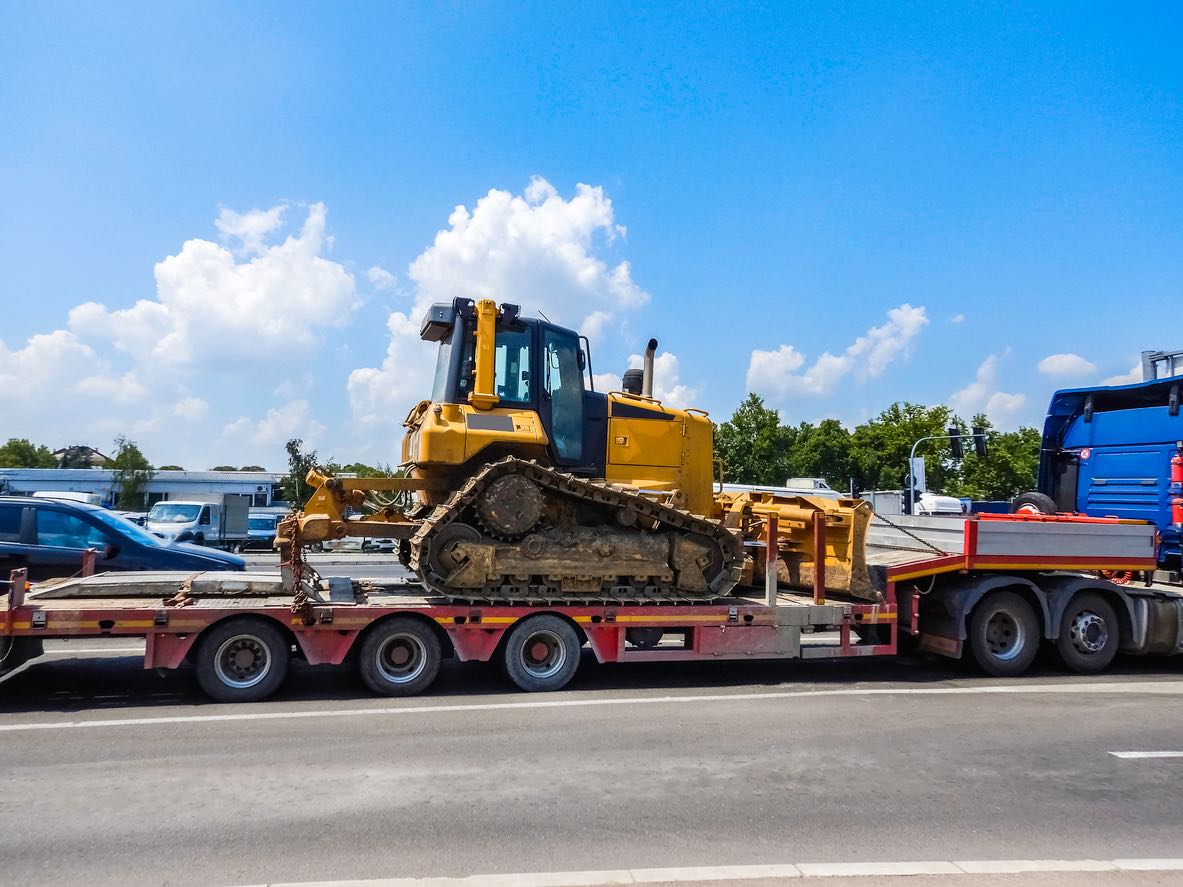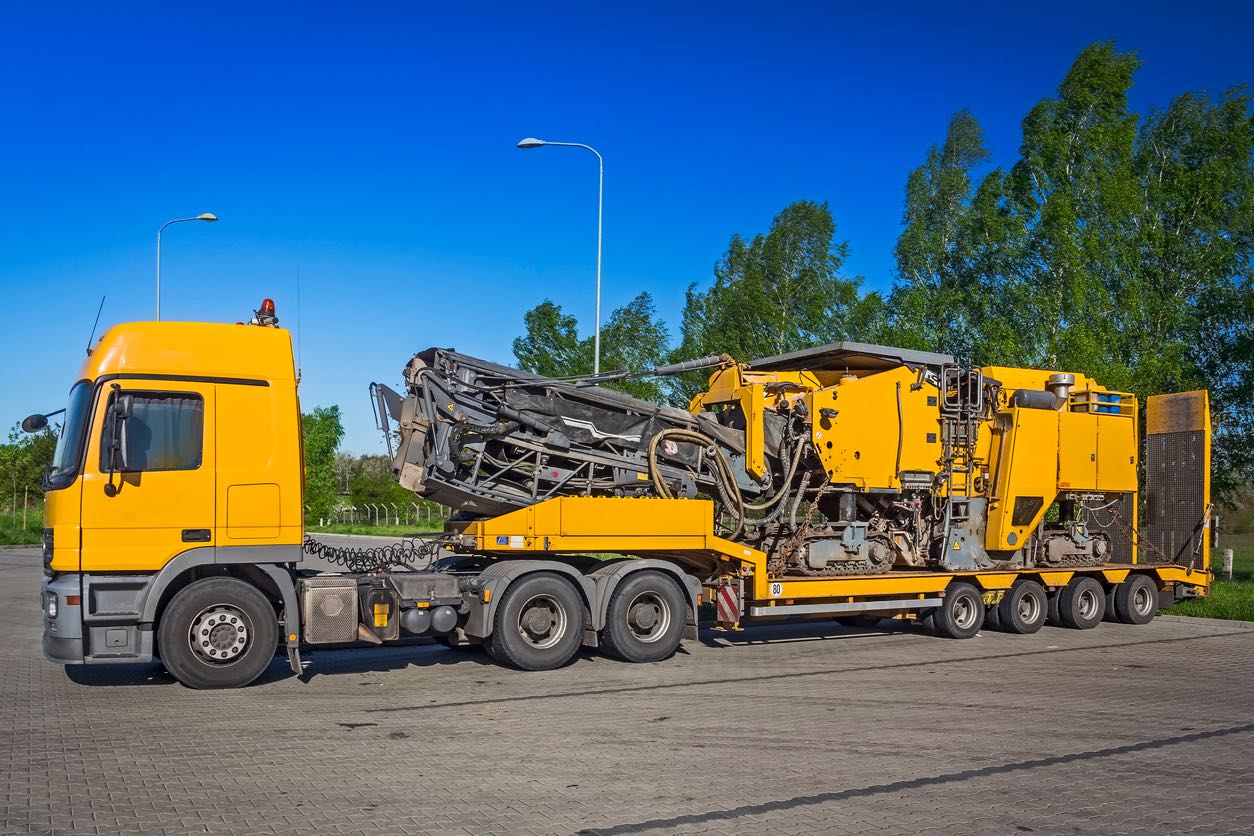The movement of heavy machinery stands out as a monumental effort in the huge industrial environment, sometimes obscured by the machinery’s primary duties. But as any seasoned operator can tell, these behemoths’ mobility is just as important as their operating functions. Heavy equipment transportation involves a variety of complex considerations, particularly given the size of the United States. The difficulties are as great as the technology itself, ranging from legal restrictions to logistical disasters.
There is no shortage of information in the digital era, yet it can be difficult to cut through the clutter to obtain precise, useful insights. Many firms struggle with the difficulties of equipment transportation, particularly those who are new to the world of heavy machinery. What constitutes heavy machinery is a topic of much debate. When is the use of an escort car required? How can the transportation process be made safe and effective? Although they may appear simple, these questions go right into the center of a highly specialized field.
The goal of this publication is to clarify the heavy equipment transportation industry. We make an effort to give a thorough overview of the procedure by drawing on industry insights and professional perspectives. This text promises to clarify the subtleties of shipping heavy equipment in the United States, whether you’re an experienced industry veteran seeking for a refresher or a beginner eager to learn the ropes. Join us as we make our way through this complex journey’s motorways and backroads.

Heavy equipment transportation is a complex and essential industry. The transportation of such equipment is not only a logistical difficulty but also a crucial element of operational efficiency in sectors where huge gear plays a key role. Transporting agricultural equipment between states or transferring cranes from one construction site to another calls for knowledge, dexterity, and a thorough awareness of safety procedures. This section explores the intricate details of heavy equipment transportation, emphasizing its significance, the benefits of consulting specialists, and the difficulties involved.
The Need for Equipment Transportation: The relocation of heavy machinery becomes more than simply a logistical challenge when a company’s activities are inextricably linked to its usage of it; it becomes a lifeline. Moving equipment between locations isn’t only for convenience; it’s also important to maintain operational efficiency, keep projects on schedule, and cut down on downtime. The prompt delivery of equipment can often be the difference between achieving project deadlines and incurring expensive delays. Therefore, a key component of project planning and execution is comprehending and budgeting for equipment transportation.
The Best Option: Heavy machinery transportation is not a job for the inexperienced. Engaging with seasoned heavy haulers with expertise in this specialized field may be transformative. These professionals are prepared with knowledge of best procedures, the appropriate tools, and an awareness of the routes that are most appropriate for such transport. Businesses who choose a heavy equipment shipping expert not only assure the timely and safe delivery of their machinery, but they also avoid the possible difficulties and hazards of attempting to handle such a challenging operation internally.
Complexity and Safety: There are several potential difficulties in moving large pieces of equipment. Every stage requires careful consideration, from the size and weight of the equipment to the unique needs of various states and areas. Frequently, additional permits are required for the movement of such equipment, especially when doing so over state boundaries or through areas with poor infrastructure. In order to ensure the safety of the machinery and the employees involved, the transportation equipment, such as trailers and rigs, must also be carefully picked. In summary, despite the complexity of the work, it can be carried out successfully with the correct knowledge, ensuring that the equipment reaches its destination in the best possible shape.

The world of heavy machinery is broad and diverse, including a large range of equipment utilized in many sectors. These pieces of machinery shape our constructed environment, from soaring buildings to vast motorways, and are frequently distinguished by their size, power, and utility. However, the phrase “heavy equipment” refers to more than just huge machines. In many settings, it has particular meanings, particularly when it comes to transportation and judicial definitions. This section clarifies the term’s numerous meanings in an effort to demystify it.
The Overall Feeling: When the majority of people hear the word “heavy equipment,” they frequently picture sizable, durable gear that is generally found at construction sites or industrial areas. Our frequent experiences with such machinery, whether it be an excavator building a road or a crane carrying materials onto a structure, form our general image of it. The broader understanding is frequently used by heavy haul shipping companies, which specialize in carrying these enormous devices. They consider the equipment’s usability, functioning, and transportation difficulties in addition to its size.
In Legal Terms: The concept of heavy machinery is more specific from a legal perspective. It describes equipment that is either self-propelled, self-powered, or pull-type. This indicates that the machinery can move independently, either using an internal engine or an outside power source, or it may be pulled by another vehicle. These pieces of equipment are mostly used in the forestry, industrial, and construction industries. Backhoes, bulldozers, and other huge industrial machinery are some examples. The legal definition is essential since it frequently establishes rules, safety requirements, and operational policies for enterprises.
Heavy-Haul Transportation: The phrase “heavy haul” carries a lot of weight in the transportation industry. It especially refers to shipments that are larger and/or heavier than permitted by Department of Transportation (DOT) standards. Transporting huge machinery is only one aspect of this; another is making sure that the transportation complies with safety and legal requirements. Special permissions, route planning, and even escorted vehicles throughout transportation may be needed for oversized equipment. The difficulties associated with moving heavy equipment over long distances highlight how crucial experience and careful preparation are to its safe and effective transportation.

Heavy equipment transportation is a challenging undertaking that needs careful preparation and execution, especially for big shipments. The deployment of escort cars is one of the crucial aspects of this procedure. By serving as the primary transport vehicle’s eyes and ears, these vehicles are crucial to guaranteeing the efficient and safe transportation of heavy equipment. Their presence not only helps to avert potential accidents, but also makes sure that the transportation follows the rules established by the relevant authorities. In this part, we’ll go into more detail on the importance of escort vehicles, the dangers of ignoring their use, and the elements that make them necessary.
What Escort Vehicles Are All About: When it comes to big freight, escort vehicles, also known as pilot cars, are a crucial component of the transportation process. Their major job is to direct the main transport vehicle and make sure it moves smoothly through roads, bridges, and tunnels. These trucks have specific communication equipment that enables them to keep in touch with the driver of the primary transport vehicle at all times. By doing this, they are able to offer real-time information on the state of the roads, the flow of traffic, and any possible roadblocks.
The Dangers of Cutting Costs: There may be severe repercussions if escort vehicles are not used. Bridge strikes are among the most frequent dangers connected to ignoring their use. Due to their height, oversized cargo might easily crash with bridges if not handled properly. In addition to causing considerable financial losses, such occurrences can also jeopardize the driver’s and other road users’ safety. Additionally, the lack of an escort vehicle leaves the primary transport vehicle on its own to negotiate traffic and other dangers, raising the risk of accidents and delays.
Making a Need Assessment: It’s not arbitrary to request escort cars. When establishing their requirement, a number of criteria are taken into account. For instance, the length of the trailer bed may determine whether one or more escort vehicles are required. Due to their weight, longer beds frequently need extra support when negotiating twists and tight spaces. The type of cargo being transported, as well as its height and weight may also influence the decision. Always, preventing potential mishaps and making sure that the equipment is transported safely are the main objectives. Transporters must be familiar with these regulations since various state regulatory authorities could have distinct restrictions regulating the employment of escort cars.
It may be challenging to navigate the world of big haul shipping, especially when it comes to comprehending the associated expenses. Transporting large pieces of machinery requires a major time and financial commitment from both enterprises and private persons. Clients are frequently confused by the complexities of pricing and the countless elements that affect the ultimate price. This section seeks to provide a clear and thorough explanation of what one may anticipate in order to demystify the expenses related to big haul transportation. In order to provide clarity and direction to customers wishing to transport heavy equipment, we have broken down the numerous factors that go into the total cost.
The Complexities of Pricing: The cost of heavy equipment transportation reflects the complexity of this complicated procedure. Heavy haul shipping calls for a more complex strategy than conventional shipping, which frequently has set prices depending on size or weight. Each piece of equipment may require particular transit methods, extra labor, or special handling techniques based on its characteristics. In order to ensure that customers receive a service that is in line with the specific requirements of their equipment, the cost for heavy haul shipping is thus customized to the particular demands of each assignment.
Cost-Relating Factors: There are a number of factors that affect how much heavy haul shipping costs. The equipment’s weight is the first important consideration. In order to move heavier equipment securely, it may be necessary to use specialist trucks or other resources. The ever-changing cost of fuel is also a major factor in the ultimate pricing. Given the considerable distances that these large components frequently travel, transportation costs are increasing along with gasoline prices. Permits are also a very important factor. Heavy or large equipment transportation sometimes need for specific permissions, which are expensive. Finally yet importantly, the actual travel distance plays a big role in the decision. Longer trips result in higher fuel expenses, as well as greater wear and tear on vehicles and perhaps longer durations, all of which add to the overall cost of shipping.

The logistics of moving large pieces of equipment can be challenging, and the stakes are quite high. Businesses need a reliable partner who not only comprehends the complexities of carrying big gear but also appreciates efficiency and transparency. In this situation, Ship A Car, Inc. (SAC) stands out as a reliable example. SAC guarantees that transferring heavy gear is no longer a herculean chore for businesses via a dedication to clear communication, fair pricing, and a simplified procedure. Here is a closer examination of what makes them unique.
Pricing Transparency: Ship A Car distinguishes out for its dedication to upfront pricing in a sector that is plagued with surprise fees and hidden expenditures. SAC carefully crafts each quote it offers, ensuring that customers are informed of all associated expenses. When a business is honest about its price, a sense of trust develops, and SAC is aware of this. They make sure that organizations can budget confidently and properly by taking the element of surprise out of the invoicing process.
Process Simplicity: It’s not easy to move large machinery. Many people may find the necessary organization, paperwork, and logistics burdensome. Clients may now exhale with relief since SAC is in charge. The business undertakes the complex process of heavy haul transportation, handling every aspect from beginning to end. Businesses can concentrate on what they do best by taking a hands-off approach and leaving the logistics of transportation to the professionals at Ship A Car. The outcome? a stress-free, efficient, and smooth commuting experience.
The Value of Effective Logistics
In sectors where machinery is the backbone of operations, logistics is especially important when it comes to the movement of heavy equipment. It is not simply convenient; it is imperative that such equipment be carried securely, effectively, and in accordance with the law. In addition to protecting the equipment, good logistics also guarantees the security of all those taking part in the transit process. Additionally, it ensures that organizations can run without interruption or unforeseen delays. The importance of safety and the value of knowledge will be highlighted as we go into the specifics of why effective logistics are crucial in this section.
Priority One: The Department of Transportation (DOT) standards must be followed for safety reasons as well as legal compliance. These laws have been carefully designed to make sure that heavy machinery is moved without endangering people, the environment, or the machinery itself. By adhering to these rules, businesses may be sure that not only is their equipment safe from potential harm, but also that all users of the roads and highways stay safe. In essence, DOT standards provide as a guide for safe and effective transportation, placing a focus on the value of good logistics.
Experience and Knowledge Is Power: Heavy equipment transportation is a challenging task that necessitates a thorough awareness of several protocols and laws. Relying on specialists in the industry guarantees that each stage of the procedure is carried out precisely and expertly, from securing the cargo to navigating through routes and acquiring the required licenses. Professionals in the logistics industry are well-equipped with the knowledge and expertise necessary to foresee future problems and quickly come up with solutions. Their participation ensures that the transportation procedure is smooth, effective, and devoid of expensive mistakes or oversights.

Heavy haul shipping is a complex procedure that involves more than just moving bulky equipment from one place to another. It includes a variety of difficulties that need for knowledge, foresight, and careful planning. Though they are simply the tip of the iceberg, the sheer size and weight of the equipment being transported might provide special difficulties. Heavy haul transportation is fraught with possible issues that might occur at any point along the way, from loading to transit to unloading. For businesses to guarantee the timely and safe delivery of their equipment, they must have a thorough understanding of these issues.
It’s More than Just the Dimensions of the Equipment: Heavy haul transportation involves more than just the equipment’s size and weight. Although these are unquestionably important aspects, the true difficulty resides in foreseeing possible problems that can occur during travel. For instance, the form of the equipment may render it prone to wind resistance, or some components may be particularly subject to damage by road debris. The equipment’s design may also make it difficult to travel through tunnels or beneath bridges. In order to ensure that a large piece of machinery arrives in the same condition as when it left, it is not enough to simply move it from point A to point B.
Logistical Difficulties: Heavy haul transportation involves intricate and multidimensional operations. Understanding the subtleties of that path is just as important as planning a route on a map. Drivers must have excellent abilities and judgment to navigate confined situations, such as busy metropolitan areas or tight roadways. Furthermore, the driver is not solely responsible. To ensure everyone’s safety on the road, ground workers are required to warn other road users of the large load. All parties involved must carefully plan, coordinate, and communicate throughout this process, which highlights the value of experience and knowledge in this specific area of shipping.

The significance of specialist equipment in the complex world of shipping, particularly when it entails hauling large gear, cannot be understated. Precision, safety, and efficiency are necessities in the shipping sector due to the wide variety of cargo kinds and unique needs. Utilizing specialized tools designed specifically for the job at hand becomes essential to achieve these requirements. This specialized gear is crucial for preserving the integrity of the cargo being carried in addition to guaranteeing the safe and prompt delivery of cargo. Let’s explore the role special equipment plays in the shipping industry in more detail.
Customized for the Task: The size, weight, and dimensions of machinery in the heavy industry range widely. Such a wide range of machinery necessitates a careful method of transport. Depending on the size and weight of the equipment, specialized trailers made to carry big loads can be required. Furthermore, loading and unloading such equipment requires accuracy. The use of customized loading and unloading equipment that can manage the weight and size of the equipment without causing any harm may be required if standard equipment is insufficient.
Making Transit Safe: The safe and flawless delivery of the heavy haul equipment to the intended location is the main objective of every shipping operation. The risks are significantly greater when using large machines. Any transportation damage might lead to large monetary losses and operational difficulties. In this regard, specialized gear is essential. The danger of damage from improper handling, accidents, or other unanticipated conditions is considerably minimized by the use of equipment created for the task. In addition to guaranteeing the safety of the apparatus, this also gives the sender and recipient piece of mind because they know that their priceless equipment is in capable hands.
Moving things from one place to another is only one aspect of shipping heavy equipment; it also involves a complicated ballet of logistics, accuracy, and knowledge. Due to its value to continuous operations and high financial expenditure, the machinery in issue sometimes represents a considerable investment for organizations. As a result, moving heavy equipment is not a job that should be handled lightly. The highest care and attention to detail must be used in every phase, from the original planning to the final delivery. Any error can cause expensive damages and operational delays, whether it be a logistical blunder or a physical accident while in transportation.
The need of working with seasoned experts becomes immediately obvious during this complex procedure. A comprehensive grasp of the difficulties associated with shipping large equipment is brought to the table by businesses like Ship A Car, Inc. Their knowledge ensures that the equipment is not only carried securely but also gets to its destination quickly. Businesses may concentrate on their main activities while leaving the transportation of expensive equipment in the hands of such experts, giving them peace of mind that their cargo is in good hands.

Ship A Car, Inc. has carved out a position for itself as a market leader in the United States in the enormous industry of freight shipping businesses. The company’s reputation is based on more than simply its capacity to move vehicles; it also rests on a foundation of trust, dependability, and unmatched customer service. SAC continually overcomes the difficulties faced by the transportation sector, from logistical obstacles to uncontrollable outside circumstances, making sure that each vehicle is carried with the highest care and accuracy. Because of their dedication to openness, clients are never in the dark regarding the whereabouts and condition of their priceless goods.
But what actually distinguishes Ship A Car is its consistent commitment to efficiency and safety. Their network of carriers is qualified to manage a variety of vehicles and is familiar with their individual needs. The combination of this rigorous attention to detail with cutting-edge machinery and technology ensures consistently smooth shipping. Customers may relax in the knowledge that the vehicles are in the capable hands of a business that cherishes their trust and consistently pursues excellence.
- Why is hiring experts for hauling heavy equipment necessary? Moving a piece of heavy equipment from place A to place B is only one aspect of shipping it. It entails a variety of difficulties, from securing unique permits to overcoming logistical difficulties. Specialists in the sector have the knowledge, skills, and resources necessary to manage these complexities successfully. They make sure that each step is carried out precisely and carefully since they are knowledgeable about the complexities of moving large machinery.
- How can Ship A Car, Inc. offer pricing transparency? The core value of Ship A Car is transparency. The business starts off by giving customers a thorough overview of prices. This thorough approach avoids the potential of unanticipated fees or hidden costs. Their open pricing policy provides that customers are knowledgeable about every step of the shipping process, enabling them to plan their finances precisely and with confidence.
- Can Ship A Car, Inc. manage shipment to other countries? Ship A Car, Inc. primarily focuses on domestic shipping inside the United States, but they also have a network of reliable partners for needs regarding overseas shipment. Customers who want to ship vehicles outside the U.S. can talk to the company’s experts about their needs to identify the best option.
- How does the business manage unforeseen difficulties or shipment delays? Unexpected difficulties might occur in the dynamic world of shipping because of bad weather, traffic jams, or other unforeseen circumstances. Ship A Car, Inc. takes great pleasure in being proactive. The business keeps lines of communication open with its customers, keeping them informed of any possible delays and the steps being taken to resolve them. Their backup preparations and knowledgeable crew make sure that any problems are resolved quickly, reducing inconveniences.
Ship A Car, Inc. strives to provide its customers with clarity and confidence by providing answers to the questions that are most frequently asked, so ensuring that the shipping process will be easy and trouble-free for them.




